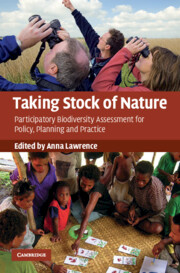Book contents
- Frontmatter
- Contents
- List of contributors
- Acknowledgements
- 1 Introduction: learning from experiences of participatory biodiversity assessment
- 2 Monitoring and assessment of biodiversity under the Convention on Biological Diversity and other international agreements
- 3 The Millennium Ecosystem Assessment: a multi-scale assessment for global stakeholders
- 4 Conservation of biological diversity in El Salvador shade coffee: the importance of taxonomic capacity for participatory assessments
- 5 Taking stock of nature in species-rich but economically poor areas: an emerging discipline of locally based monitoring
- 6 Researching local perspectives on biodiversity in tropical landscapes: lessons from ten case studies
- 7 Participatory resources monitoring in SW China: lessons after five years
- 8 Forest inventory in Nepal – technical power or social empowerment?
- 9 Perceptions of landscape change in British Columbia's Northwest: implications for biodiversity and participatory management
- 10 How thousands planned for a billion: lessons from India on decentralized, participatory planning
- 11 Inside monitoring: a comparison of bird monitoring groups in Slovenia and the United Kingdom
- 12 The personal and political of volunteers' data: towards a national biodiversity database for the UK
- 13 Improving forest management through participatory monitoring: a comparative case study of four community-based forestry organizations in the Western United States
- Index
- References
7 - Participatory resources monitoring in SW China: lessons after five years
Published online by Cambridge University Press: 06 December 2010
- Frontmatter
- Contents
- List of contributors
- Acknowledgements
- 1 Introduction: learning from experiences of participatory biodiversity assessment
- 2 Monitoring and assessment of biodiversity under the Convention on Biological Diversity and other international agreements
- 3 The Millennium Ecosystem Assessment: a multi-scale assessment for global stakeholders
- 4 Conservation of biological diversity in El Salvador shade coffee: the importance of taxonomic capacity for participatory assessments
- 5 Taking stock of nature in species-rich but economically poor areas: an emerging discipline of locally based monitoring
- 6 Researching local perspectives on biodiversity in tropical landscapes: lessons from ten case studies
- 7 Participatory resources monitoring in SW China: lessons after five years
- 8 Forest inventory in Nepal – technical power or social empowerment?
- 9 Perceptions of landscape change in British Columbia's Northwest: implications for biodiversity and participatory management
- 10 How thousands planned for a billion: lessons from India on decentralized, participatory planning
- 11 Inside monitoring: a comparison of bird monitoring groups in Slovenia and the United Kingdom
- 12 The personal and political of volunteers' data: towards a national biodiversity database for the UK
- 13 Improving forest management through participatory monitoring: a comparative case study of four community-based forestry organizations in the Western United States
- Index
- References
Summary
Introduction
The opportunity to look at the effects of a participatory monitoring project several years after the end of a project is a rare one. This chapter does just that, by comparing project goals, experience one year after implementation, and five years later, in a project working with local communities in protected areas in the south-western province of Yunnan in China.
China's efforts in biodiversity conservation have increased in the last decade. China was one of the first countries to ratify the Convention on Biological Diversity (CBD) in 1992, and to formulate its National Biodiversity Conservation Action Plan (NBCAP) (Wang et al., 2000). This plan specifically addresses the need to integrate conservation, development and local livelihoods, and to monitor the impacts of biodiversity conservation efforts. Its implementation has become, to a large extent, the responsibility of local government because of decentralizing reforms. Local government – county, township, and village committees – are mandated to formulate policies and develop regulations for natural resources management. They must, however, comply with the Chinese constitution and laws, and with higher level regulations and policies (Dupar and Badenoch, 2002). Consequently, national policies concerning land tenure, protected areas, agriculture development and rural cooperatives will have a great impact on implementation of the plan at local levels. However, support has not been provided for local institutions to develop sound environmental governance at village and township levels (Dupar and Badenoch, 2002).
- Type
- Chapter
- Information
- Taking Stock of NatureParticipatory Biodiversity Assessment for Policy, Planning and Practice, pp. 142 - 164Publisher: Cambridge University PressPrint publication year: 2010
References
- 2
- Cited by

